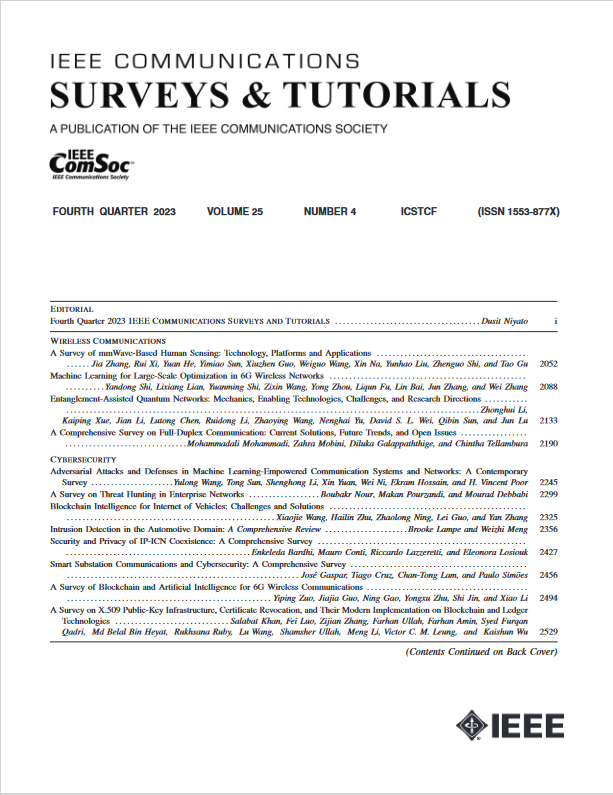RIS-Empowered Satellite-Aerial-Terrestrial Networks With PD-NOMA
IF 34.4
1区 计算机科学
Q1 COMPUTER SCIENCE, INFORMATION SYSTEMS
引用次数: 0
Abstract
Satellite-aerial-terrestrial network (SATN) is considered as a promising architecture for sixth-generation (6G) wireless communication networks to achieve seamless coverage, flexible wireless access, and high data rate. Moreover, non-orthogonal multiple access (NOMA), and reconfigurable intelligent surface (RIS) can significantly increase spectrum and energy efficiency. Recently, the integration of these two technologies and SATN has attracted a lot of attention both in academia and industry. This survey provides a comprehensive overview of RIS-empowered SATN with NOMA. In particular, the rudimentary knowledge of SATN, NOMA scheme, and RIS technology is presented. Then, the motivations for investigating the NOMA-RIS-assisted SATN are discussed. In addition, we introduce the three usage modes of RIS, two scenarios of NOMA-RIS, and the path loss model of NOMA-RIS-assisted SATN. Next, the system performance is analyzed for a case study. Besides, a comprehensive overview of resource allocation in NOMA-RIS-assisted SATN is provided, where theoretical and artificial intelligence-based methods are compared and analyzed. Moreover, physical layer security and covert communication are selected as two representative security techniques to be discussed in NOMA-RIS-aided SATN. Furthermore, the combination of other emerging technologies with NOMA-RIS-assisted SATN is investigated. Finally, this survey provides a detailed discussion of the main challenges and open issues that need to be deeply investigated from a practical point of view, including channel modeling, channel estimation, deployment strategies, and backhaul control.利用 PD-NOMA 的 RIS 增强型卫星-空中-地面网络
卫星-空中-地面网络(SATN)被认为是第六代(6G)无线通信网络的一种有前途的架构,可实现无缝覆盖、灵活的无线接入和高数据速率。此外,非正交多址接入(NOMA)和可重构智能表面(RIS)可显著提高频谱和能源效率。最近,这两项技术与 SATN 的整合引起了学术界和产业界的广泛关注。本研究全面概述了由 RIS 和 NOMA 驱动的 SATN。其中特别介绍了 SATN、NOMA 方案和 RIS 技术的基本知识。然后,讨论了研究 NOMA-RIS 辅助 SATN 的动机。此外,我们还介绍了 RIS 的三种使用模式、NOMA-RIS 的两种应用场景以及 NOMA-RIS 辅助 SATN 的路径损耗模型。接下来,我们分析了一个案例研究的系统性能。此外,还对 NOMA-RIS 辅助 SATN 中的资源分配进行了全面概述,并对理论方法和基于人工智能的方法进行了比较和分析。此外,还选择了物理层安全和隐蔽通信作为 NOMA-RIS 辅助 SATN 的两种代表性安全技术进行讨论。此外,还研究了其他新兴技术与 NOMA-RIS 辅助 SATN 的结合。最后,本调查报告从实际角度详细讨论了需要深入研究的主要挑战和未决问题,包括信道建模、信道估计、部署策略和回程控制。
本文章由计算机程序翻译,如有差异,请以英文原文为准。
求助全文
约1分钟内获得全文
求助全文
来源期刊

IEEE Communications Surveys and Tutorials
COMPUTER SCIENCE, INFORMATION SYSTEMS-TELECOMMUNICATIONS
CiteScore
80.20
自引率
2.50%
发文量
84
审稿时长
6 months
期刊介绍:
IEEE Communications Surveys & Tutorials is an online journal published by the IEEE Communications Society for tutorials and surveys covering all aspects of the communications field. Telecommunications technology is progressing at a rapid pace, and the IEEE Communications Society is committed to providing researchers and other professionals the information and tools to stay abreast. IEEE Communications Surveys and Tutorials focuses on integrating and adding understanding to the existing literature on communications, putting results in context. Whether searching for in-depth information about a familiar area or an introduction into a new area, IEEE Communications Surveys & Tutorials aims to be the premier source of peer-reviewed, comprehensive tutorials and surveys, and pointers to further sources. IEEE Communications Surveys & Tutorials publishes only articles exclusively written for IEEE Communications Surveys & Tutorials and go through a rigorous review process before their publication in the quarterly issues.
A tutorial article in the IEEE Communications Surveys & Tutorials should be designed to help the reader to become familiar with and learn something specific about a chosen topic. In contrast, the term survey, as applied here, is defined to mean a survey of the literature. A survey article in IEEE Communications Surveys & Tutorials should provide a comprehensive review of developments in a selected area, covering its development from its inception to its current state and beyond, and illustrating its development through liberal citations from the literature. Both tutorials and surveys should be tutorial in nature and should be written in a style comprehensible to readers outside the specialty of the article.
 求助内容:
求助内容: 应助结果提醒方式:
应助结果提醒方式:


